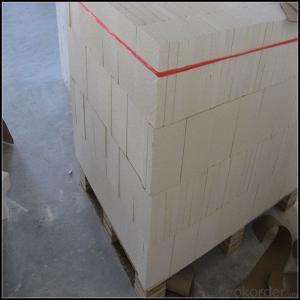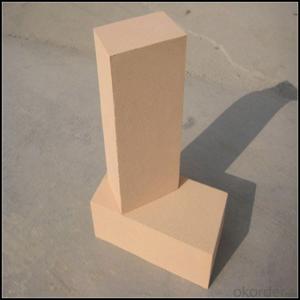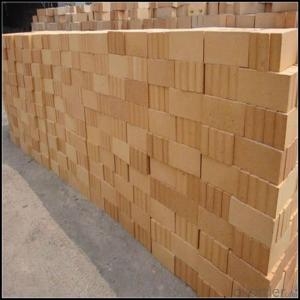SK32, SK34 Fireclay Refractory Brick for Kiln Use
- Loading Port:
- China main port
- Payment Terms:
- TT OR LC
- Min Order Qty:
- 1 m.t
- Supply Capability:
- 800 m.t/month
OKorder Service Pledge
OKorder Financial Service
You Might Also Like
Refractory Brick
CMAX firebricks are classified under temperature between 1300℃ to 1700℃, manufactured from high purity alumina clay by mixing, press-forming, drying, sintering and machining. Bricks contain carefully-graded organic fillers which are burned out during sintering to give a uniform controllable pore structure. This technique makes product feature low thermal conductivity and excellent heat insulation

Features
1. Certificate of Quality for each parcel
2. Raw material from China, Australia and Germany
3. Good price
4. Many sizes in stock ; Making tiles accroding to your drawings
5. Resistance: Excellent
6. Quick delivery& Professional service
Application
1.Carbon bake furnaces in the aluminium industry
2.Preheat zones and cyclones of rotary cement kilns
3.Insulation for glass tanks
4.Coke ovens
5.Blast furnaces
6.Reheating furnaces
7.Suspended roofs
8.Lime kilns
9.chimney
Data Sheet
Classification Temperature (℉/℃) | 3000/1650 |
Bulk Density (g/cm3 ) | ≤1.0 |
Thermal Conductivity | |
800℃, W/m.K | ≤0.39 |
1000℃, W/m.K | ≤0.43 |
1200℃, W/m.K | ≤0.48 |
Reheating Linear Change (%) | 1550℃×12h |
≤0.9 | |
Chemical Composition (%) | |
Al2O3 | ≥75 |
Fe2O3 | ≤0.5 |
Packaging & Shipping
Packaging Details:Be packed in fumigated wooden pallets
Delivery Detail: 30 days after order

Our Services
Optimum solution and product supply of refractories for high temperature industries, such as iron steel, non-ferrous, petrochemical and building materials.
Engineering design, contract and consult for refractories, and civil architecture design.
Research, development, manufacture and sale of superhard materials.
R&D, manufacture and sale of special packing materials for export.
Inspection, supervision and arbitration of refractories.
Consultation and services in refractories information.
Training and cultivation of high-level talents in refractories profession
Sales Network

Company Information
CNBM (China National Building Material) Group is the largest comprehensive building materials group in China that in integrate scientific research, manufacturing and logistics into one entity. The largest building materials and equipment specialists in China. Upon State Council approval, today CNBM owned more than 300 subordinate manufacturing factories and servicing companies. There are 6 fully owned public listed companies and 11 partially owned with substantial shares public listed companies. In many of these fields, CNBM is playing the leading role in the building industry in the country.
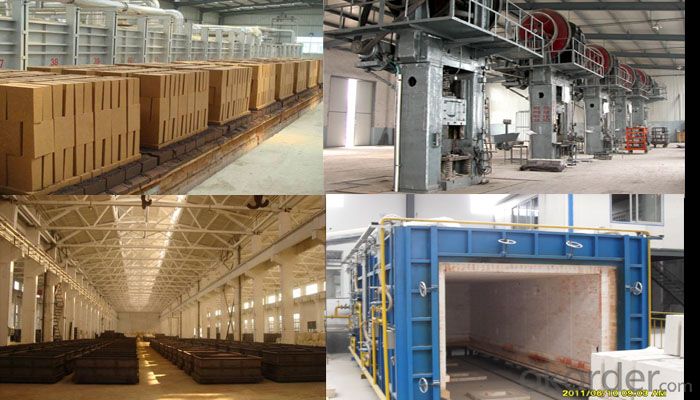
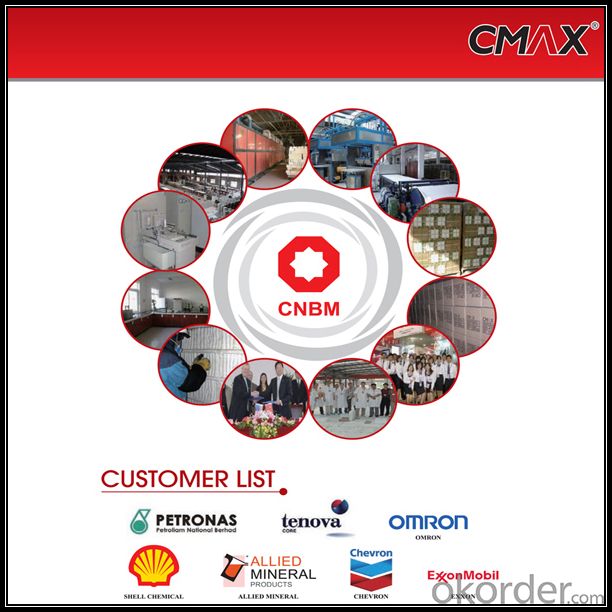
FAQ
1. Which products do you have?
We have all kinds of refractory brick, castable, mortar, cement, ceramic fiber products, etc.
Or you could browse our products to choose what you need.
2. Can you give me a brief introduction of the application of your products?
We are mainly specializing in the refractory materials in iron and steel, cement, glass, ceramics, petrochemical, electric power Industry, etc.
3. If I need your offer, what information do you need?
In order to choose suitable products, it will be appreciated to provide us the information, such us specification, technical data, order quantity, products application etc. If any question, please contact us freely.
- Q:Are insulating fire bricks resistant to water penetration?
- Yes, insulating fire bricks are resistant to water penetration. These bricks are designed to have a low porosity and are made from materials that are not prone to absorbing or retaining water. They are typically composed of lightweight refractory materials such as alumina, silica, and other minerals that have high heat resistance and low water absorption properties. This makes insulating fire bricks ideal for applications where water penetration could be detrimental, such as in high-temperature environments or when used as insulation in chimneys or kilns. However, it is important to note that while these bricks are resistant to water penetration, they are not completely impervious to it. Prolonged exposure to water may eventually lead to some level of water absorption, which can affect their insulating properties. Therefore, it is advisable to take precautions and ensure proper installation and maintenance to maximize their resistance to water penetration.
- Q:Are insulating fire bricks environmentally friendly?
- Insulating fire bricks can be considered environmentally friendly to a certain extent. These bricks are made from natural materials such as clay, shale, and other minerals, which are abundant and readily available. This means that they do not contribute to the depletion of natural resources. Additionally, insulating fire bricks are designed to have low thermal conductivity, which helps in reducing energy consumption. By using these bricks, buildings can be better insulated, resulting in lower heating and cooling requirements and subsequently reducing greenhouse gas emissions. However, the manufacturing process of insulating fire bricks does have some environmental impacts. The firing process requires high temperatures, which can contribute to air pollution and greenhouse gas emissions. Furthermore, the extraction of raw materials for these bricks may involve some environmental disturbance. To truly assess the environmental friendliness of insulating fire bricks, it is important to consider the entire life cycle, including the extraction of raw materials, manufacturing process, transportation, and disposal. Additionally, comparing them to alternative insulation materials can provide a more comprehensive perspective on their environmental impact. In conclusion, while insulating fire bricks have certain eco-friendly characteristics like being made from natural materials and reducing energy consumption, their overall environmental impact should be evaluated in a holistic manner.
- Q:Can insulating fire bricks be used in the construction of hearths?
- Yes, insulating fire bricks can be used in the construction of hearths. These bricks are designed to withstand high temperatures and provide excellent insulation, making them ideal for use in hearth construction. They help to retain heat and prevent the loss of energy, ensuring efficient and effective heating.
- Q:Can insulating fire bricks be used for insulation in sewage treatment plants?
- Yes, insulating fire bricks can be used for insulation in sewage treatment plants. Insulating fire bricks are specifically designed to withstand high temperatures and provide excellent insulation, making them suitable for use in environments where heat and moisture are present, such as sewage treatment plants. These bricks have low thermal conductivity, which helps to reduce heat loss and increase energy efficiency in the treatment process. Additionally, their resistance to chemicals and moisture makes them ideal for withstanding the corrosive environment found in sewage treatment plants. Therefore, insulating fire bricks can effectively provide insulation in sewage treatment plants, helping to maintain optimum operating temperatures and improve overall efficiency.
- Q:How long do insulating fire bricks last?
- Insulating fire bricks are designed to withstand high temperatures and provide excellent insulation properties. The lifespan of insulating fire bricks can vary depending on several factors such as the quality of the bricks, the temperature they are exposed to, and how well they are maintained. Generally, insulating fire bricks can last for several years, often ranging from 10 to 20 years or even longer. However, it is important to note that the lifespan can be significantly reduced if the bricks are exposed to extreme temperatures or thermal shock on a regular basis. Regular maintenance and proper usage can also extend the lifespan of insulating fire bricks. This includes regular cleaning to remove any debris or build-up that can impact their performance. It is also important to avoid sudden temperature changes or excessive stress on the bricks, as this can lead to cracking or damage. Overall, the longevity of insulating fire bricks can vary, but with proper care and maintenance, they can provide reliable insulation for many years in high-temperature applications.
- Q:Are insulating fire bricks resistant to moisture penetration?
- Yes, insulating fire bricks are resistant to moisture penetration.
- Q:Do insulating fire bricks require any special installation techniques?
- Special installation techniques are necessary for insulating fire bricks. These bricks are designed to offer excellent thermal insulation, so proper installation is essential for optimal performance. To begin, it is crucial to have a clean and debris-free installation surface. This creates a strong and stable foundation for the bricks. Afterward, it is important to use a suitable refractory mortar or adhesive to secure the bricks in place. This mortar should be specifically designed for high-temperature applications and capable of withstanding thermal expansion and contraction during heating and cooling cycles. During installation, attention should be given to filling the joints between the bricks with mortar. This prevents heat loss and maintains the insulating properties of the bricks. Furthermore, careful stacking and alignment of the insulating fire bricks is necessary to ensure a tight fit and minimize gaps. This maximizes insulation and prevents heat leakage. Lastly, it is advisable to consult the manufacturer's guidelines and follow their recommended installation techniques. Different types of insulating fire bricks may have specific requirements that must be adhered to for proper installation. In summary, insulating fire bricks demand special installation techniques to ensure their effectiveness and longevity. Following proper installation practices will enhance the thermal insulation properties of these bricks and optimize their performance.
- Q:How do insulating fire bricks affect the overall insulation properties of a structure?
- Insulating fire bricks greatly enhance the insulation properties of a structure due to their low thermal conductivity. These bricks effectively minimize heat transfer and prevent the escape of heat, resulting in improved energy efficiency and reduced heating costs. Additionally, their high resistance to heat and excellent thermal stability contribute to maintaining a consistent and comfortable indoor temperature.
- Q:Do insulating fire bricks have low thermal conductivity?
- Yes, insulating fire bricks have low thermal conductivity. These bricks are specifically designed to minimize heat loss and provide excellent insulation properties. The low thermal conductivity of insulating fire bricks is due to their composition, which typically includes lightweight materials such as clay, silica, and alumina. These materials have low thermal conductivity, meaning they are not efficient at transferring heat. As a result, insulating fire bricks are highly effective at reducing heat transfer and maintaining high temperatures within a structure. This makes them ideal for applications that require insulation against high temperatures, such as in kilns, furnaces, and fireplaces.
- Q:How thick are insulating fire bricks?
- The thickness of insulating fire bricks usually falls between 2.5 and 4 inches (6.35 to 10.16 cm), varying based on the manufacturer and the intended purpose of the bricks. With the ability to endure extreme temperatures and offer exceptional insulation, these bricks are well-suited for application in kilns, furnaces, and other environments with high temperatures.
1. Manufacturer Overview |
|
|---|---|
| Location | |
| Year Established | |
| Annual Output Value | |
| Main Markets | |
| Company Certifications | |
2. Manufacturer Certificates |
|
|---|---|
| a) Certification Name | |
| Range | |
| Reference | |
| Validity Period | |
3. Manufacturer Capability |
|
|---|---|
| a)Trade Capacity | |
| Nearest Port | |
| Export Percentage | |
| No.of Employees in Trade Department | |
| Language Spoken: | |
| b)Factory Information | |
| Factory Size: | |
| No. of Production Lines | |
| Contract Manufacturing | |
| Product Price Range | |
Send your message to us
SK32, SK34 Fireclay Refractory Brick for Kiln Use
- Loading Port:
- China main port
- Payment Terms:
- TT OR LC
- Min Order Qty:
- 1 m.t
- Supply Capability:
- 800 m.t/month
OKorder Service Pledge
OKorder Financial Service
Similar products
New products
Hot products
Related keywords
